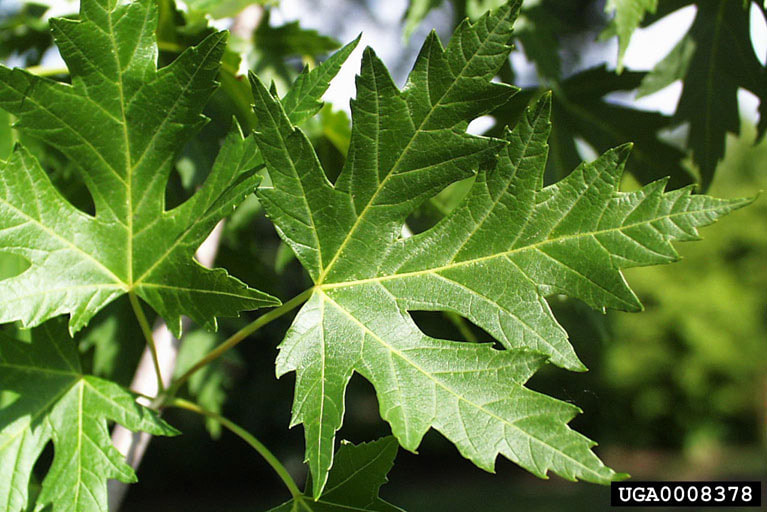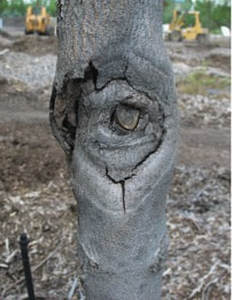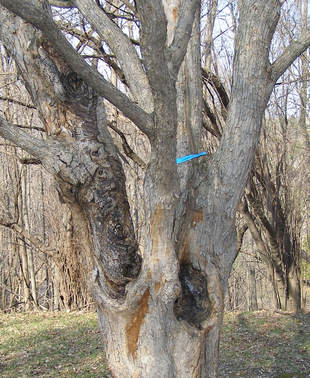web page by Emily Reif, 2018
Photo by: P. Wray, Iowa State University, Bugwood.org
background
Eutypella canker is a fungal disease that affects all plants of the genus Acer (maple) (1). The canker typically forms on the trunk or large branches within 9 feet of the ground and trees smaller than 4 inches in diameter are typically killed if the canker girdles the trunk (1). This disease is considered moderate because it is an annual, slow growing callus, which doesn't immediately kill the tree (2). The affected tree can live with it for many decades decay becomes an issue (1). Decay typically requires trees in urban areas to be removed due to the hazardous potential (1).
origin & life cycle
This disease was first discovered on sugar maple (Acersaccarum) and red maple (Acer rubrum) in 1935 in the Great Lakes region of North America (3). The causal agent, Eutypella parasitica, was discovered in 1938 (3). This fungus spreads during rain events when the spores are released into the air from infected trees (1). The spores can be carried up to 75 feet by the wind and will affect trees that have been recently wounded or pruned (1,3). After infection, the fungus spreads underneath the bark, killing the cambium, phloem, and eventually the sapwood (1). Each year in the spring following infection, the fungus will spread outward up to 1 inch per year and as a response the tree will create a layer of wound wood at the edge of the canker, causing the bull’s eye effect (figure 1) (1,2).
signs & symptoms
- Callus around the infection point usually with a branch stub in the center (figure 1) (1,2,3)
- Large areas of rough bark with a sunken center and callus around the perimeter (2)
- Black fungal fruiting structures on bark near center of cankers that are over 5 years old (1,2)
- Cream colored fungus mat underneath healthy bark surrounding callus (2,3)
Figure 1. Eutypella Canker on trunk of young maple
Photo by: S. Schimek, MN Dept. of Agriculture (1)
Photo by: S. Schimek, MN Dept. of Agriculture (1)
Figure 2. Eutypella canker on mature maple
Photo by: Michelle Grabowski
University of Minnesota Extension
Photo by: Michelle Grabowski
University of Minnesota Extension
treatment & control
- Avoid wounding the trunk and branches (1)
- When pruning, avoiding wounding the main trunk and never leave branch stubs (1)
- Prune out infected or cankered branches and destroy immediate (1)
- Pruning cuts should be at least 4 to 6 inches below the canker (2)
- Pruning should only be done when the weather and wood is dry (2)
- The infected wood should be buried or burned to avoid the spread of fungus spores (1)
- Cankers on the main trunk should be monitored and removed if they become hazardous (1,2)
Work Cited
- Koetter, R., & Grabowski, M. (n.d.). Eutypella Canker. Retrieved February 06, 2018, from https://www.extension.umn.edu/garden/yard-garden/trees-shrubs/eutypella-canker/
- Moorman , G. M. (n.d.). Eutypella Canker On Maple. Retrieved February 06, 2018, from https://extension.psu.edu/eutypella-canker-on-maple
- Kessler Jr., K.J. & Hadfield, J.S. USDA Forest Service. (1972). Eutypella Canker of Maple. Forest Pest Leaflet 136. Retrieved March 14, 2018, from https://www.fs.usda.gov/Internet/FSE_DOCUMENTS/fsbdev2_043571.pdf



